OTHER WORKS
vitroskyline
water from other worlds
joining horizons
schillerlocken
map of views
imprecise island
self portrait
many maps
SCHILLERLOCKEN
The work of art consists of 27 pastry cones stuffed with photocopies of the letters of the Book by Friedrich Schiller On the Aesthetic Education of Man in a Series of Letters. Clarendon Press, Oxford, 1982. I took one page of every one of the 27 letters, of an edition printed in German and English, written with my comments in Spanish. Schillerlocke is the German commercial name of this pastry product, whose translation is Schiller's curl.
During the reading of Schiller's letters the presence of the German and English languages together in every page, made me think about the content and the artificiality of them. I observed the distance between idioms; the possible distance of them with what Schiller really thought, and with my own language too. I began to see how I turned what I was thinking into artificial words and also into other languages. So the arbitrariness of the languages provoked me to think over how abstract the Reason, as a system of rules is. The letters were turned into mere surface, matter; as physical amount, as stuffing material in the pages. Thus, I could only contemplate the letters.
This work of art came up as a way of experimenting the kind of contemplation that Schiller expresses, which removes the object of the desire, putting a distance around the object. Schiller says that "contemplation (or reflection) is the first liberal relation which man establishes with the universe around him" (SCHILLER, Friedrich. "On the Aesthetic Education of Man" p.193)
The main point of Interest in Schiller´s letters is the conflict between pairs of opposed concepts, mainly between Nature and Reason, and other pairs as: Sense/Spirit, Physique/Idea, Matter/Moral, Contingent/Permanence, Limitation/Infinite. This work mainly embodies his ideas about the material and immaterial: things and thoughts, taste drive and Reason. Food and language are here combined through strategies that bring them closer to each other, but provoke the dysfunction of both. Food is used in the particular form of a "Schillerlocke" - stuffed pastry cones - which is for the taste sense, related to the impermanence. The concept of Thought is taken not by its conceptual substance but by the material dimension of the language: photocopies of the book in its bilingual edition: German and English. The problem about the opposition between these two realities of different nature, with which we must deal with in everyday life, is never solved.
"As long as man is still a savage he enjoys by means of these tactile senses alone…" (SCHILLER, Friedrich. "On the Aesthetic Education of Man" p.195) He also argues that when man begins to enjoy through the eye, he is aesthetically free and is developing the play drive. But… at the end of all, like Schiller also said, "… we are dealing with a finite, not with an infinite, mind" (SCHILLER, Friedrich. "On the Aesthetic Education of Man" p.133).
The work of art consists of 27 pastry cones stuffed with photocopies of the letters of the Book by Friedrich Schiller On the Aesthetic Education of Man in a Series of Letters. Clarendon Press, Oxford, 1982. I took one page of every one of the 27 letters, of an edition printed in German and English, written with my comments in Spanish. Schillerlocke is the German commercial name of this pastry product, whose translation is Schiller's curl.
During the reading of Schiller's letters the presence of the German and English languages together in every page, made me think about the content and the artificiality of them. I observed the distance between idioms; the possible distance of them with what Schiller really thought, and with my own language too. I began to see how I turned what I was thinking into artificial words and also into other languages. So the arbitrariness of the languages provoked me to think over how abstract the Reason, as a system of rules is. The letters were turned into mere surface, matter; as physical amount, as stuffing material in the pages. Thus, I could only contemplate the letters.
This work of art came up as a way of experimenting the kind of contemplation that Schiller expresses, which removes the object of the desire, putting a distance around the object. Schiller says that "contemplation (or reflection) is the first liberal relation which man establishes with the universe around him" (SCHILLER, Friedrich. "On the Aesthetic Education of Man" p.193)
The main point of Interest in Schiller´s letters is the conflict between pairs of opposed concepts, mainly between Nature and Reason, and other pairs as: Sense/Spirit, Physique/Idea, Matter/Moral, Contingent/Permanence, Limitation/Infinite. This work mainly embodies his ideas about the material and immaterial: things and thoughts, taste drive and Reason. Food and language are here combined through strategies that bring them closer to each other, but provoke the dysfunction of both. Food is used in the particular form of a "Schillerlocke" - stuffed pastry cones - which is for the taste sense, related to the impermanence. The concept of Thought is taken not by its conceptual substance but by the material dimension of the language: photocopies of the book in its bilingual edition: German and English. The problem about the opposition between these two realities of different nature, with which we must deal with in everyday life, is never solved.
"As long as man is still a savage he enjoys by means of these tactile senses alone…" (SCHILLER, Friedrich. "On the Aesthetic Education of Man" p.195) He also argues that when man begins to enjoy through the eye, he is aesthetically free and is developing the play drive. But… at the end of all, like Schiller also said, "… we are dealing with a finite, not with an infinite, mind" (SCHILLER, Friedrich. "On the Aesthetic Education of Man" p.133).






